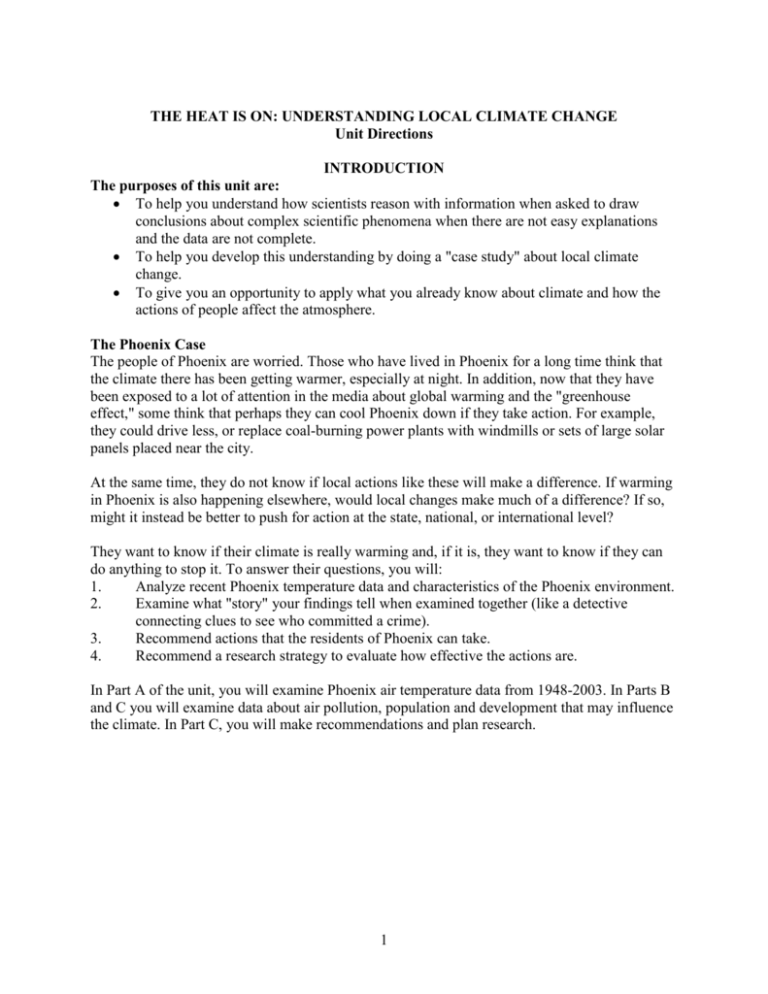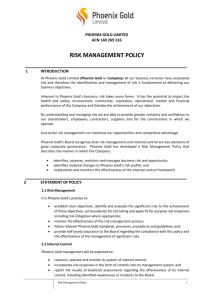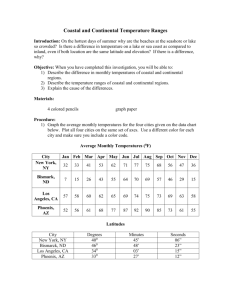
THE HEAT IS ON: UNDERSTANDING LOCAL CLIMATE CHANGE
Unit Directions
INTRODUCTION
The purposes of this unit are:
To help you understand how scientists reason with information when asked to draw
conclusions about complex scientific phenomena when there are not easy explanations
and the data are not complete.
To help you develop this understanding by doing a "case study" about local climate
change.
To give you an opportunity to apply what you already know about climate and how the
actions of people affect the atmosphere.
The Phoenix Case
The people of Phoenix are worried. Those who have lived in Phoenix for a long time think that
the climate there has been getting warmer, especially at night. In addition, now that they have
been exposed to a lot of attention in the media about global warming and the "greenhouse
effect," some think that perhaps they can cool Phoenix down if they take action. For example,
they could drive less, or replace coal-burning power plants with windmills or sets of large solar
panels placed near the city.
At the same time, they do not know if local actions like these will make a difference. If warming
in Phoenix is also happening elsewhere, would local changes make much of a difference? If so,
might it instead be better to push for action at the state, national, or international level?
They want to know if their climate is really warming and, if it is, they want to know if they can
do anything to stop it. To answer their questions, you will:
1.
Analyze recent Phoenix temperature data and characteristics of the Phoenix environment.
2.
Examine what "story" your findings tell when examined together (like a detective
connecting clues to see who committed a crime).
3.
Recommend actions that the residents of Phoenix can take.
4.
Recommend a research strategy to evaluate how effective the actions are.
In Part A of the unit, you will examine Phoenix air temperature data from 1948-2003. In Parts B
and C you will examine data about air pollution, population and development that may influence
the climate. In Part C, you will make recommendations and plan research.
1
Background information about Phoenix
Phoenix is in a desert valley in South Central Arizona, surrounded on most sides by mountains.
Below is a map of Arizona from Mapquest1 which shows where Phoenix is located.
The map below shows where Arizona is in the United States2
Phoenix has an arid, semitropical climate all year, and the climate changes very little from
season to season. Clear blue skies are typical on most days. Phoenix has an average of 300 sunny
days per year. The temperature reaches or exceeds 100 °F (38 °C) on an average of 89 days
during the year, including most days from early June through early September.
Part A. Phoenix's highest and lowest temperatures
1
2
http://www.mapquest.com/atlas/main.adp?region=arizona
http://media.maps101.com/SUB/K_3/k3uspolit.gif
2
The first data you will examine are lowest (minimum) and highest (maximum) temperatures in
Phoenix from 1948 to 2003. The National Geophysical Data Center (NGDC) posts these data
and data from thousands of weather stations around the world on the Web. The data are part of
the Global Historical Climate Network (GHCN), a massive multi-year international project to
measure temperature, precipitation, and air pressure from near the ground. Each monthly
maximum and minimum temperature is the highest and lowest temperature reading for the
month, measured in Celsius. In Phoenix and in most other places, the temperature data are
collected at local airports.
The red dots in the image below show where the temperature monitoring stations are located in
the world:
(retrieved from http://lwf.ncdc.noaa.gov/img/climate/research/ghcn/ghcnv2.mean.gif)
(For more information about how you can get to these data at the NGDC web site, go to the
Climate Unit web site and open the article entitled "Navigating the Global Historical Climate
Network data at the National Geophysical Data Center.")
You will examine the Phoenix temperature readings from 1948 to 2003 because they are
complete. Other years are missing some readings, including the years after 2003.
Open the Excel spreadsheet file called "Phoenix Min.". Save the file to a place indicated by your
teacher and give it a new name that identifies it as your version of the file. Your teacher will tell
you how to name it.
Notice how there are rows for all the years, 12 columns displaying the monthly minimum
(lowest) temperatures, and a column displaying the annual mean (average) of those monthly
lows. The temperatures were recorded at the Phoenix airport.
3
A1.
Produce and save a graph that helps you figure out which of these two claims you agree
most with.
Claim 1: The data show enough of a pattern of increase between 1948 and 2003 to
indicate that the climate in Phoenix is warming.
Claim 2: The data DO NOT show enough of a pattern of increase between 1948 and 2003
to indicate that the climate in Phoenix is warming.
Write which claim you agree with and explain how your graph supports your answer.
Copy your graph to your unit response sheet. Save the file again and close it.
Open the Excel spreadsheet file called "Phoenix Max.". Follow the same directions you just
followed with the "Phoenix Max" file. Save the file to a place indicated by your teacher and give
it a new name that identifies it as your version of the file. Your teacher will tell you how to name
it.
These data have the same structure as “Phoenix Min” and were also recorded at the airport.
However, they are each month’s maximum (highest) temperatures.
A2.
Produce and save a graph that helps you figure out which of these two claims you agree
most with.
Claim 1: The data show enough of a pattern of increase between 1948 and 2003 to
indicate that the climate in Phoenix is warming.
Claim 2: The data DO NOT show enough of a pattern of increase between 1948 and 2003
to indicate that the climate in Phoenix is warming.
Write which claim you agree with and explain how your graph supports your answer.
As you did before with the minimum temperature graph, copy your maximum temperature graph
to your unit response sheet. Save the file again and close it.
Part B. 30-year mean temperature changes
You have been examining data showing year-by-year differences in how warm and how cold it
got at the Phoenix airport every month between 1948 and 2003. Map 1 (below) shows changes in
mean (average) annual temperatures around the world between 1975 and 2005. The map was
produced by a geographic information system, a type of software program that produces
“visualizations” of data on maps. The arrow points to the approximate location of Phoenix.
Map 1. Global distribution of mean temperature changes, 1975-2005 3
3
Cited image from Hansen, J., Sato, M., Ruedy, R., Lo, K. Lea, David W., Medina-Elizade, (2006). M. Global
temperature change. Proceedings of the National Academy of Sciences, Vol. 103, p 14288. Published online Sept.
25, 2006. Retrieved on 5/18/2007 from http://www.pnas.org/cgi/reprint/0606291103v1.pdf. Image retrieved from
4
Study the map legend at the top of the map. Then answer questions B1-B5.
B1.
B2.
B3.
B4.
Is the amount of increase in Phoenix the same as in the rest Arizona or is it different? If it
is different, is it much larger, a bit larger, a little smaller, or much smaller? Answer the
question, then explain your answer.
Comparing 1975 and 2005, has Phoenix experienced one of the biggest increases in the
world, one of the slowest increases, or somewhere in between? Answer the question, then
explain your answer.
Do you see any relationships between where the increases have been the biggest and
where they have been the smallest? If you notice patterns, explain them.
Someone looked at Map 1 and said the map does not convince her that global warming is
occurring. She said she wants more evidence. What other data would be worth collecting
for evidence, and why.
Pearce, Fred. One Degree and We're Done For. New Scientist. Vol. 191., Number 2571, September 30, 2006. p. 8.
Retrieved on 5/18/2007 from http://www.newscientist.com/data/images/archive/2571/25713301.jpg.
5
B5.
Use the table on your response sheet to compare and contrast how useful are the Excel
data you examined in Part A and these global data on Map 1 for drawing a conclusion
about whether or not the climate in Phoenix is getting warmer.
Part C. Phoenix’s environment
You will now investigate data sets about what people are doing that may be affecting the
climate in Phoenix. (Scientists call these “anthropogenic” influences).
The data sets have different structures:
different spans of years (e.g., 1990-2002, 1940-2000)
different intervals between when the data are collected (e.g., each month, each year, etc.)
different geographic coverage (e.g., all of Arizona, just Phoenix)
different representations (e.g., maps, tables)
Introduction to questions C -C3
Map 2 on the next page shows global carbon emissions in 1987. The data are estimates of the
amount of carbon released into the atmosphere that year by people and machines (such as
automobiles) burning fossil fuels. They come from studies conducted by researchers at NASA
for a program called the Climatology Interdisciplinary Data Collection. They are measured in
kilograms of carbon per square kilometer. The key at the bottom shows that the colors represent
a range of 0 to 4,483,132 kilograms.
(Please note: The carbon emissions data only represent levels over land, NOT over oceans, so
ignore the ocean areas' brown color.)
6
Map 2. Global carbon emissions in 1987
(Background information about the map: The map was made in a geographic information system
(GIS) software program called My World™. My World™ allows you to zoom in to a smaller
area, such the greater continental U.S. region shown on the next page. In My World™ and other
GIS programs, “gridded” data sets such as the carbon emissions data sets are displayed on square
cells, each with its own measurement of the average for the area. There are 64,800 cells on the
entire world image. Each individual cell's area is 78,704 square kilometers. Some of the cells are
obvious because they contrast sharply with their surrounding areas.)
C1.
Compare Maps 1 and 2. Is there a relationship between places where the mean
temperatures increased the most and where carbon emissions were greatest in 1987? Or is
there perhaps somewhat of an inverse relationship, or no relationship at all? Explain your
conclusion, and cite data from the maps that support it. (An inverse relationship is one in
which two variables affect each other in opposite ways. For example, with adults, age is
inversely related to health. The more your age increases, the more your health
decreases).
7
Map 3 below zooms in on the carbon emissions in the continental United States (the lower 48
states). On this map are the locations of major U.S. cities. The city symbols are triangles and
their different sizes are represented by different colors. For example, the blue triangles represent
bigger cities than do the red triangles.
Map 3. Carbon emissions in the Continental United States in 1987
C2.
Examine Maps 2 and 3. How much carbon were people in Phoenix emitting in 1987
compared with the rest of North America? Give a general answer.
8
Map 4 below zooms in on Arizona. The arrows point to the places on the map where, for each
square kilometer, certain average amounts of carbon were emitted by the people and machines
there. For example, in the dark brown square area that contains Phoenix, an average of 873,191
kilograms of carbon were emitted per square kilometer.
Map 4. Arizona Carbon Emissions in 1987 4
C3.
Examine Map 4. How much carbon per square kilometer were people in Phoenix emitting
in 1987 compared with the rest of Arizona?
4
Carbon emissions data set copied from software program WorldWatcher: A Global Visualizer for Windows, Version
3. Created by the SSciVEE and WorldWatcher Curriculum Projects at Northwestern University. GIS images from
My World™, Version 4.02. Copyright © 2000-2006 Northwestern University. All Rights Reserved.
9
To answer each of the next set of questions, C4-C12, fill in columns F and G on the rows of the
Synthesis Table on your answer sheet. Each row is labeled. So, for example, to answer question
C4, fill in the two cells in row 1, columns F and G. (The row numbers are in Column A).
C4-C12 are about different “variables” that may have an effect on the local climate. (Variables
are factors that can be expressed in numbers. For example, the variable “age” is a numeric factor
that influences peoples’ health.)
In the rows of Column F, rate how much each variable has changed. In Column G, explain your
ratings.
C4.
Carbon emissions from different sectors of the economy. Figures 1-3 below show how
much carbon dioxide (CO2) was emitted in Arizona, from 1990 to 2002, in each of the
five major sectors of the economy (commercial, industrial, residential, transportation, and
electric power). 1 unit = 1 million metric tons of carbon dioxide. Notice for example that
1,870,000 (1.87 million) metric tons were emitted in the commercial sector in 1990.
On Row 1 of your Synthesis Table, rate the trend in these data and explain your rating.
Figure 1: Table view of the totals
Commercial
(e.g., stores,
businesses,
offices, etc)
Industrial (e.g.,
factories, etc.)
Residential
(e.g., homes,
apartments,
etc.)
Transportation
(e.g., cars,
buses, aircraft,
etc.)
Electric Power
(e.g., power
plants)
TOTAL
1990
1991
1992
1993
1994
1995
1996
1997
1998
1999
2000
2001
2002
1.87
1.80
1.74
1.71
1.79
1.76
1.84
1.94
2.23
2.15
2.14
2.04
2.14
3.82
3.88
3.89
3.91
4.30
4.63
5.01
5.15
4.88
4.98
4.93
5.01
4.48
1.83
1.89
1.76
1.72
1.81
1.70
1.66
1.84
2.17
2.09
2.14
2.19
2.20
22.55
23.06
23.39
24.73
25.46
25.86
27.39
27.40
29.51
31.20
31.99
33.02
33.83
32.20
62.27
32.44
63.07
35.02
65.80
36.22
68.29
37.64
71.01
31.98
65.92
31.98
67.88
34.65
70.99
36.51
75.31
39.01
79.43
43.84
85.04
45.08
87.34
44.12
86.77
10
1990
1991
1992
1993
1994
1995
1996
1997
1998
1999
2000
2001
2002
To
ta
l
In
du
st
er
c
C
om
m
R
es
id
en
tia
Tr
l
an
sp
or
ta
tio
El
n
ec
tri
c
Po
w
er
ria
l
100.00
90.00
80.00
70.00
60.00
50.00
40.00
30.00
20.00
10.00
0.00
ia
l
Millions of metric tons of CO2
Figure 2: Graph view of the totals
Figure 3. Graph view of the percentages by year and sector
100.00
90.00
80.00
Millions of metric tons of CO2
70.00
60.00
Electric Power
Transportation
Residential
Industrial
Commercial
50.00
40.00
30.00
20.00
10.00
0.00
1990
1991
1992
1993
1994
1995
1996
11
1997
1998
1999
2000
2001
2002
Questions C5-C7 are about Arizona air pollution data from 1996 to 2006. The data were
collected by U.S. Environmental Protection Agency (EPA) at many different pollution
monitoring stations. The U.S. government sets standards about how much air pollution is
acceptable and the data show how many times the levels were higher than the standards allow.
The pollutants that were higher than standards allow during the years of data collection were (1)
carbon monoxide, (2) ozone, and (3) particulate matter.5
Background information about the effects of the three pollutants on climate:
Carbon monoxide contributes to the greenhouse effect indirectly by chemically reacting
with other elements in the troposphere that increase the amount of ozone. Carbon
monoxide also reacts with methane, a greenhouse gas.
Ozone is created when nitrous dioxide and volatile organic compounds react
photochemically with sunlight. In the troposphere, ozone is a greenhouse gas that
contributes to warming.
Particulate matter is an “aerosol” that helps cool the atmosphere by shielding it from
some solar radiation that would otherwise reach the earth’s surface. Scientists call this
cooling effect "dimming." (There are natural sources of aerosols as well, such as dust,
volcanoes, and forest fires.)
C5.
The row of data below shows the number of days per year on which the Environmental
Protection Agency recorded levels of carbon monoxide that, in the Phoenix area,
exceeded acceptable standards. On Row 2 of your Synthesis Table, rate the trend in these
data and explain your rating.
Carbon
Monoxide
C6.
Ozone
1996
1997
1998
1999
2000
2001
2002
2003
2004
2005
2006
2
1
0
1
0
0
0
0
0
0
0
The row of data below shows the number of days per year on which the Environmental
Protection Agency recorded levels of ozone that, in the Phoenix area, exceeded
acceptable standards. Examine the data. On Row 3 of your Synthesis Table, rate the trend
in these data and explain your rating.
1996
1997
1998
1999
2000
2001
2002
2003
2004
2005
2006
5
2
4
2
2
2
2
2
0
0
0
5
Only particulate matter with diameters of less then 10 micrometers were exceeding standards in Phoenix in these
years.
12
C7.
The row of data below shows the number of days per year on which the Environmental
Protection Agency recorded levels of particulate matter that, in the Phoenix area,
exceeded acceptable standards. Examine the data. On Row 4 of your Synthesis Table,
rate the trend in these data and explain your rating.
Particulat
e matter
1996
1997
1998
1999
2000
2001
2002
2003
2004
2005
2006
0
40
0
0
6
0
0
36
0
6
1
The information on the next page is about effects on the climate that result from how humans
change their environments These are called Urban Heat Island effects. READ THIS ARTICLE.
It will help you make sense of the data. Then, answer questions C8 and C9.
13
What Is a Heat Island?
The term "heat island" refers to urban air and surface temperatures that are higher than nearby
rural areas. Many U.S. cities and suburbs have air temperatures up to 10°F (5.6°C) warmer than
the surrounding natural land cover.
How Do Heat Islands Form?
Heat islands form as cities replace natural land cover with pavement, buildings, and other
infrastructure. These changes contribute to higher urban temperatures in a number of ways:
Displacing trees and vegetation minimizes the natural cooling effects of shading and
evaporation of water from soil and leaves (evapotranspiration).
Tall buildings and narrow streets can heat air trapped between them and reduce air flow.
Waste heat from vehicles, factories, and air conditioners may add warmth to their
surroundings, further exacerbating the heat island effect.
When Do Heat Islands Form?
Heat islands can occur year-round during the day or night. Urban-rural temperature differences
are often largest during calm, clear evenings. This is because rural areas cool off faster at night
than cities, which retain much of the heat stored in roads, buildings, and other structures. As a
result, the largest urban-rural temperature difference, or maximum heat island effect, is often
three to five hours after sunset.
Are Heat Islands and Global Warming Related?
Heat islands describe local-scale temperature differences, generally between urban and rural
areas. In contrast, global warming refers to a gradual rise of surface temperatures over the whole
earth.
While they are distinct phenomena, summertime heat islands may contribute to global warming
by increasing demand for air conditioning, which results in additional power plant emissions of
heat-trapping greenhouse gases. Strategies to reduce heat islands, therefore, can also reduce the
emissions that contribute to global warming.
How Are Heat Islands Measured?
Heat islands are typically measured by the temperatures on horizontal surfaces or in the air (at
about 5 feet above the ground). Surface-based measurements record energy reflected and emitted
from the land, including roofs, pavements, vegetation, bare ground, and water.
14
C8.
The table and graph below shows the total population of Phoenix every 10 years since
1940.6 On Row 5 of your Synthesis Table, rate the trend in these data and explain your
rating.
Year
Population
1940
65,400
1950
106,800
1960
439,200
1970
581,600
1980
789,700
1990
983,400
2000
1,321,000
Phoenix Population
1,400,000
1,200,000
1,000,000
800,000
Population
600,000
400,000
200,000
0
1940 1950 1960 1970 1980 1990 2000
Year
6
http://www.library.uu.nl/wesp/populstat/Americas/usat.htm.
15
C9.
The images below show the physical size of the Greater Phoenix Area (Phoenix and its
suburbs) in 1973 and 1992.7 The physical size was measured in square miles of
developed land. The developed land is colored red. On Row 6 of your Synthesis Table,
rate the trend in these data and explain your rating.
The Greater Phoenix Area in 1973
The Greater Phoenix Area in 1992
232 square miles of developed land.
7
471 square miles of developed land.
http://pubs.usgs.gov/circ/2004/circ1252/10.html
16
C10.
Examine again your minimum temperature graph (from Part A). On Row 7 of your
Synthesis Table, rate the trend in these data and explain your rating.
C11.
Examine again your maximum temperature graph (from Part A). On Row 8 of your
Synthesis Table, rate the trend in these data and explain your rating.
C12.
Examine again the mean temperature change map (from Part B). On Row 9 of your
Synthesis Table, rate the trend in these data and explain your rating.
C13.
Give an example of how the factors you’ve been examining affect the urban climate in a
systemic way or, in other words, in a way that shows how the climate is a system of
interacting factors that vary by time or by geography.
17
Part D. Conclusions and recommendations
D1.
Do the data you have been examining in the unit convince you that the climate in
Phoenix is getting warmer? Write yes or no here:
Then, if yes is your answer, what data in particular? If no is your answer, why not, and
what other data should be collected to investigate further?
Questions D2-D4 are about how to reduce warming in Phoenix. Answer them even if you are
not convinced that the temperature data you have been examining in the unit indicates
climate change.
D2.
D3.
D4.
D5.
If Phoenix is warming, what factors might be contributing to it? (Hint: think about the
information you’ve read in the unit about air pollution, the urban heat island effect, and
about differences between the minimum and maximum temperature changes in Phoenix.)
If Phoenix is warming, recommend what the government and people of Phoenix might do
to slow the warming down and give scientific reasons why what you recommend could
be effective.
Propose a research strategy for evaluating if the actions you recommend have the desired
effect on the climate. State:
what data you propose to collect, and why
where you propose to collect the data (hint: propose to collect at least some data in
Phoenix, but you can also collect it from other places)
how often you recommend collecting it, and why
for how long (months, years, etc.) you recommend collecting it, and why
On a scale of 1 to 10, where one equals very doubtful and 10 equals very confident, rate
how confident you are with your answers to D1-D4. Then, explain your rating. Include:
what you know and what you don't know from the data
what might be alternative explanations
18









